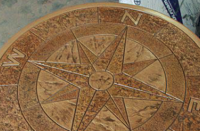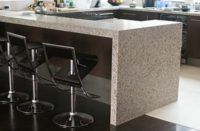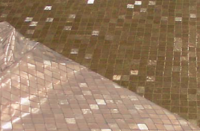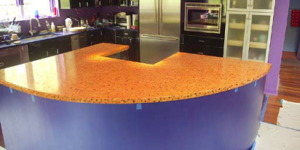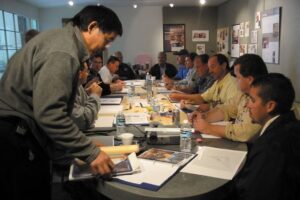
Mark Celebuski, general manager of Pinnacle Cast Concrete, wants to share some of his hard-earned wisdom with the readers of Concrete Decor. He has developed a list of 10 tips he thinks will help concrete countertop makers in particular improve their businesses. Enjoy.
1. Set your shop up for success. It’s easy to blame employees for shortcomings in your operation. The harder and more profitable approach is to set your shop and employees up for success.
I’m often asked what the most important piece of equipment is that fabricators should purchase. The answer is simple: An overhead crane. The most common injuries occurring in the precast industry are back and crushing injuries. Both are directly related to lifting things and setting them back down (sorry to be so obvious). Both can be very expensive – back injury claims can drag on for years.
The solution: Don’t lift heavy things by hand.
A 1-ton overhead crane that slides in one direction on an I-beam will cost you less than $3,000 in parts. Pay a professional engineer to spec the size of the I-beam and mounting configuration if you’re not comfortable with this part. You can also purchase free-standing overhead cranes that slide in both directions for about $15,000. Invest in equipment to due the heavy tasks. We can actually cast, strip, process, deliver and install a countertop without ever lifting it by hand.
2. Decide what you want to be the best at and work towards that goal.
One thing that the successful companies I’ve worked for over the years have had in common has been an intense focus on their main products. They had an easy time finishing the statement “We want to be the best at…”
The ones that were not focused were not very profitable and in some cases ceased to exist. One company I worked for that produced parking garages hired a full-time person to investigate and develop new products. Problem was, they weren’t very good at making parking garages. Their energy and money would have been far better spent improving their existing operation rather than trying something new. I saw the writing on the wall and quit just before they were bought and stripped for parts and real estate.
If you make concrete countertops, get really good at making and selling them before moving on. 3. Double the size of your shop without adding any square footage.
There is a misconception in the concrete countertop industry that concrete countertops need to stay in the mold and be moist-cured for days before stripping, and after stripping, concrete countertops must be moist-cured for an additional length of time before and during processing. This misconception cost you time and money.
Imagine turning around a kitchen in five days. If your normal turnaround was 10 days, you’ve just doubled the size of your shop.
Don’t think you can do it? I was part of a team that implemented systems and procedures to get multistory prestressed buildings done quickly. We would balance production, shipping and erection of up to 8,000 square feet a day. Casting was day one, stripping and loading to ride day two, and shipping and erecting day three. Turning a kitchen five days from templating should be a piece of cake.
4. Do, redo, learn, move on.
Ernest Hemingway rewrote the ending to “A Farewell To Arms” 39 times. My helper made his first rebar cage, looked at it, and said that he was no good at making rebar cages. What result did he expect?
We live in a society where failure is looked down on. Employees end up afraid to make a mistake. But failure is where success comes from. You need to make or do a lot of something to get good at it. If you’ve never made a concrete sink, make one. Never tried acid staining? Stain something. Forge ahead.
Don’t let fear of failure stop you from doing something, over and over if necessary.
5. Define your company and your products before someone else does it for you.
Concrete countertops continue to suffer in the media. Allegedly they stain, they crack, they curl, they warp and they are not a good choice for a working kitchen. Nothing could be further from the truth when it comes to modern concrete countertops and sinks.
Unless you (or we as an industry) take proactive steps to combat the media’s negative perceptions, things will not change.
Use your Web site as a tool to change perceptions. Get press coverage whenever you can, and hire a PR company to help if this isn’t your comfort zone. Offer to give talks at your local National Kitchen & Bath Association meeting. Invite customers to your plant. Donate an outdoor table to a charitable auction. Spread the word whenever and wherever you can. Slowly, perception will change.
6. Modernize your sales and marketing efforts.
In 1985 it took five TV commercials to achieve 85 percent penetration of TV viewing households, according to public relations master Howard Bragman. In 2008, it took 1,292 commercials to achieve the same penetration.
Not many fabricators would use TV to advertise, but this does illustrate the changing way people get information. If you don’t have a professionally done Web site with good photos, do whatever it takes to get one – no excuses. I also like to view Web site statistics that tell me how viewers got to my site, what they looked at, how longed they stayed, and so on. People get to our site and go immediately to the projects/photos page. Out of 5,000 or so visitors, less than 100 have looked at “About Us.”
Google AdWords may be the best rifle approach to advertising currently out there. You can target certain geographical areas and certain keywords. The cost is pay-per-click, so you can set the budget, and it’s very easy to do yourself. If you’re a fabricator in Walla Walla, Wash., you can get your ad shown when someone within 20 miles of Walla Walla types “concrete countertops.”
DVDs are a great way to give customers a lot of information for very little money. We’ve got 10 minutes worth of projects on one DVD that costs us about $3.25 each, including a nice full-color cover. The same information printed would cost more than $100 per piece.
7. Stay in the loop.
This year’s Surface Fabrication & Design Expo in Orlando was sparsely attended by all measurable standards. However, while I was there, I meet a manufacturer and ordered a sander that eliminated my dust problems, cut my sealer sanding in half, may eliminate the need for a second coat of sealer, and could potentially save me more than $5,000 per year. I would have never seen the sander, never talked to the manufacturer, and never had him agree to take the sander back if it didn’t work if I had not attended. One thing made the show a great success for me. There is a wealth of information-sharing going on right now, from shows to online forums. Take advantage of it.
8. Keep an ear to the ground.
Concrete countertops are a rapidly changing industry, with fabricators leapfrogging each other with products and processes. GFRC, CSA cements, new sealers, coatings, admixtures – it’s an exciting time. Keep an open mind. I like the story a farmer once told me about rats. When rats are presented with a new food source they will eat a tiny bit of it, go away for a while and see if it makes them sick. If it does, they don’t eat it again. They’re survivors.
Don’t be afraid to step out of your comfort zone. I don’t specialize in GFRC, but when I had to make a curved fireplace surround, it made the most sense, so I used it.
9. Learn to prioritize
Running a lean business can mean running out of hours in the day before everything is done. The key is to learn to prioritize.
Customers must always come first. Without them you have no company. If they want to meet on a Saturday, need a phone call returned, have a problem, need an estimate, whatever, put customers first on your list.
Next come current projects. If you’re not casting concrete for someone you’re not billing anything. Get accustomed to running projects through your plant in a timely fashion. Put pressure on yourself so your customers won’t.
Third come plant or company improvement projects. You should always have a plan for improving your operation. Here is my current list off the top of my head: Get all the pieces for the new display done, paint the restroom and cast a new vanity for it, install a dust collection system for the new sander, hang a new light fixture, install a new front door, install shelves with dispensers for the admixtures, design a simple hanging/weighing/dispensing system to use “supersacks” of cement.
10. Do what it takes to get through this economic downturn.
You would be hard-pressed to sift through a day’s worth of news and come up with some good news on the economy.
However, there is good news when it comes to concrete countertops – the demand is rising faster than the economy is dropping. The problem is that the distribution network has collapsed in some cases.
Kitchen designers have closed their doors, and the ones that are open have cut staff and are looking toward more traditional surfacing materials. I’ve seen a lot less risk-taking on the part of designers in my market. The companies that are holding their ground have doubled their advertising budget rather than cutting it, made their operation leaner (see Tip No. 3), and gotten back to customer service basics.
We’ve actually had to rethink the way we do things. In the end the companies that emerge will be stronger than before.
